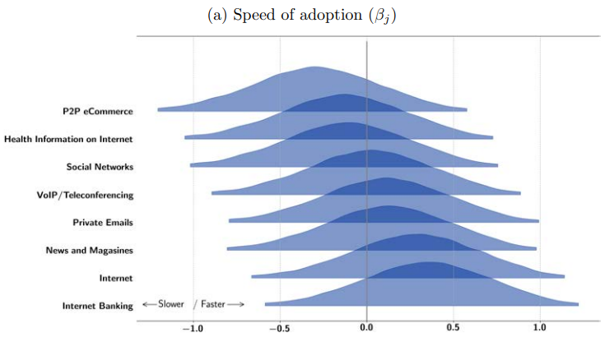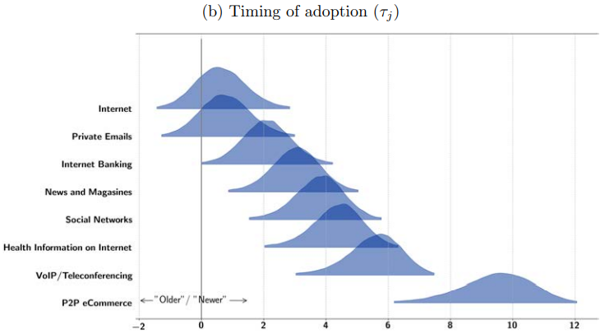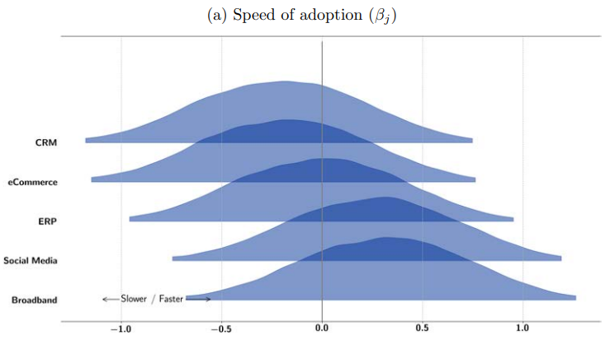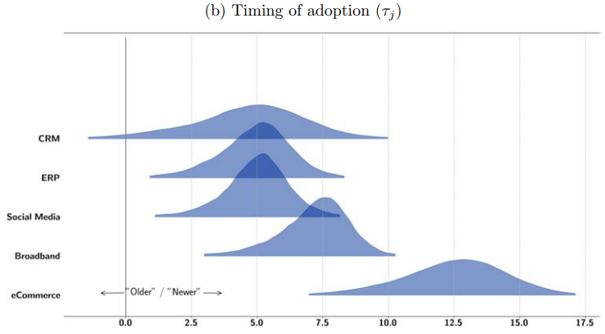

In this article, we present a new perspective on forecasting technology adoption, focused on the extensive margin of adoption of multiple digital technologies in multiple countries. We do this by applying a Bayesian hierarchical structure to the seminal model of technology diffusion. The results point to heterogeneity across countries and across technologies, mostly in the timing of adoption and, although to a lesser extent, the steady-state adoption rate once technologies are fully diffused. This suggests that characteristics of countries and technologies matter for technology diffusion, including policy choices. There are also notable differences across technologies. While the internet as a technology for households/individuals is near its peak adoption in the sample, e-commerce as a technology for firms is only a bit past the first half of its progression. Teleconferencing can potentially reach the same near universal adoption as the internet itself, although this result might be influenced by the unusual increase observed in the last year of available data, 2020.
Technology, and more generally technological progress, has long been identified as one of the engines of economic growth. As such, the adoption of productive technologies is a metric worth monitoring and projecting as a means to signal scope for policies supporting diffusion, and to guarantee that a country enjoys its maximum economic potential. This measurement comes with a wealth of challenges. Indeed, for most technologies, there is no direct observation. Some recent research aiming at identifying the intensive margin (the “amount of technology” being expended into an economy) uses a set of ad-hoc measurements, nearly one per technology. This turns comparison between technologies complex and comparison between countries contingent on the availability of a broad set of diverse statistics. The extensive margin (the share of businesses or household which have adopted a technology) is typically exclusively measured (and arguably measurable) through surveys. While such surveys have attractive features, amongst which the fact that they make comparisons between both countries and technologies relatively easy), they come with a few challenges of their own.
The most important of them is their availability. While commercial firms and surveying companies usually run market analysis for specific products, official statistical offices seldom run repeated surveys on specific technologies across countries. Even when such surveys are run and published, the data is marred by both the inherent uncertainty caused by the nature of the instrument and by missing observations for some technologies for some years in some countries.
This turns the task of making predictions from these data challenging. While the literature about technology forecasting is relatively well established (the first theoretical models describing the process where published in the 1950’s and are still largely used today1), the specificities of the data available turns the task of predicting the growth rate of the adoption of technologies, and more specifically the most recent ones, complicated.
The inherent uncertainty on the data, their irregular publication and the difficulty to perform predictions at the onset of the adoption of a new technology, precisely the time when such predictions would be the most useful, prompted us to propose a novel way of producing said forecast. Leveraging recent advances in computational techniques, we revisit the classical model of technological diffusion and allow for some information about a technology to be “transferred” to inform on the likely rate of diffusion of other technologies and, in a similar fashion, for some information about a country to inform on the typical “propensity” its population has to adopt technologies in general. As more data become available about the actual adoption of the technology or in the country, the model relies increasingly less on information coming from other technologies or countries and becomes more precise. Concretely, rather than considering each technology or each country as either completely different from or exactly as the other, we prompt the model to stand somewhere in the middle while it does not have enough information to decide.
These features are included by estimating the model using Bayesian techniques. Those techniques have the interesting additional properties to include the inherent uncertainty in the observation by design. Besides the additional computational cost, they require making a judgement about the likely values one expects to observe as a “first gross approximation” (the prior). In our paper, we set up those priors based on both previous literature on technology adoption and we set them in such a way that we are unlikely to exclude reasonable values. Moreover, we monitor a set of statistics to guarantee that we have expended sufficient computational resources to have a valid result (the so-called convergence of the result) and that the results remain in the field of what one would expect.
We then apply the model specifically on several digital technologies. On the one hand, we analyse technologies used by households, and on the other those used by businesses. For both, we rely on the data provided by the OECD. Both the scope of technologies and of countries is relatively wide. Analysing the coefficient we estimate, we observe that, while there are countries that adopt systematically technologies earlier and faster both for consumer and enterprise digital technologies, the effect of country characteristics is usually dwarfed by the intrinsic characteristic of the technology themselves. In this regard, and perhaps unsurprisingly, northern European economies appear to adopt digital technologies sooner and faster as, for instance, countries in South America. Moreover, using the model, we can make an educated guess about the likely future trajectories of technologies.
While from Figure 1, the internet itself is, relatively logically, near its peak adoption in the sample (with some local differences, of course), it seems that e-commerce in firms (meaning, the number of firms selling through digital channel) would be a bit past the first half of its progression – and the growth will now likely decelerate. This can be seen in Figure 2. It also seems that teleconferencing can potentially reach near universal adoption (meaning that 100% of household will use it in the next ten years, nearly as much as the internet itself), although this result might be influenced by the unusual increase observed in the last year of available data, 2020.
Figure 1: relative speed of diffusion and its timing for technologies used by households/individuals


Source: OECD (2020) ICT Access and Usage by Households and Individuals. Notes: in this figure, a timing of 0 means that a technology has reached the inflection point of its diffusion – the time at which adoption of a technology is at the half of its long-term maximal value – around 2005. Similarly, a value of 10 means this inflection point has been reached around 2015. The speed coefficients should just be understood as constituting a relative ranking (internet banking is likely to diffuse faster than Peer-to-Peer eCommerce).
Figure 2: relative speed of diffusion and its timing for technologies used by firms


Source: OECD (2020) ICT Access and Use by Businesses. Notes: in this figure, a timing of 0 means that a technology has reached the inflection point of its diffusion – the time at which adoption of a technology is at the half of its long-term maximal value – around 2006. Similarly, a value of 13 means this inflection point has been reached around 2019. The speed coefficients should just be understood as constituting a relative ranking (Connection to the internet through broadband (100MBits/s) is likely to diffuse faster than the Customer Relations Systems).
Our article concludes by presenting some diagnostic statistics of the model. While it depicts the likely adoption and the uncertainty associated with such adoption very well in the short run, it tends to slightly underestimate the adoption at a longer horizon (5 years). However, the most striking aspect of the model is that it performs very well when no or very few information is available on a new technology. In this case, the short-run forecast density corresponds to the observation (meaning that the model manages to depict both the value of the adoption and the uncertainty associated with it). As the model receives more information on the technology, it starts underestimating the likely short-term adoption a bit, owing to the ’pooling effects’ that are common with conservative priors as used here2. In conclusion, the model can be used as a guide to forecast the adoption of recent technologies, but the addition of another model might be considered to predict the likely adoption of technologies that are more mature.
Our paper therefore proposes a new way of estimating likely technology adoption across technologies and countries in a way that incorporates both the information available at the moment the forecast is made as well as the uncertainty inherent to this information. It performs well in settings where few data is available and is based on sensible priors, leading to the production of intuitively coherent forecast when applied to the available data on digital technology adoption. This model is but a start and would benefit from both more data and methodological refinement. Moreover, it might be argued that a share of technologies are adopted in substitution of others. Studying the dynamics of this substitution, as well as digging deeper into the reasons being for the observed coefficients in a quantitative fashion, would be natural next steps to understand why some technologies diffuse faster, sooner or more than other ones, and therefore be able to implement targeted policies supporting technology diffusion.
Comin, D. and Hobijn, B. (2010) An exploration of technology diffusion. American Economic Review, 100(5):2031–2059, doi: 10.1257/aer.100.5.2031, URL: https://www.aeaweb.org/articles?id=10.1257/aer.100.5.2031.
Mahajan, V., Muller, E. and Bass, F.M. (1990) New product diffusion models in marketing: A review and directions for research. Journal of Marketing, 54(1):1–26, doi: 10.1177/002224299005400101, URL: https://doi.org/10.1177/002224299005400101.
Lenk, P.J. and Rao, A.G. (1990) New models from old: Forecasting product adoption by hierarchical Bayes procedures. Marketing Science, 9(1):42–53, doi: 10.1287/mksc.9.1.42, URL: https://doi.org/10.1287/mksc.9.1.42.
Mansfield, E. (1961) Technical change and the rate of imitation. Econometrica, 29(4):741–766, ISSN: 00129682, 14680262, URL: http://www.jstor.org/stable/1911817
See, for example, Mansfield, E. (1961). More recent contributions include Mahajan, V., Muller, E. and Bass, F.M. (1990), Lenk, P.J. and Rao, A.G. (1990) and Comin, D. and Hobijn, B. (2010).
As it starts suffering the ”pooling effects” which are inherent to the conservative prior estimates that are good practice in such Bayesian models.